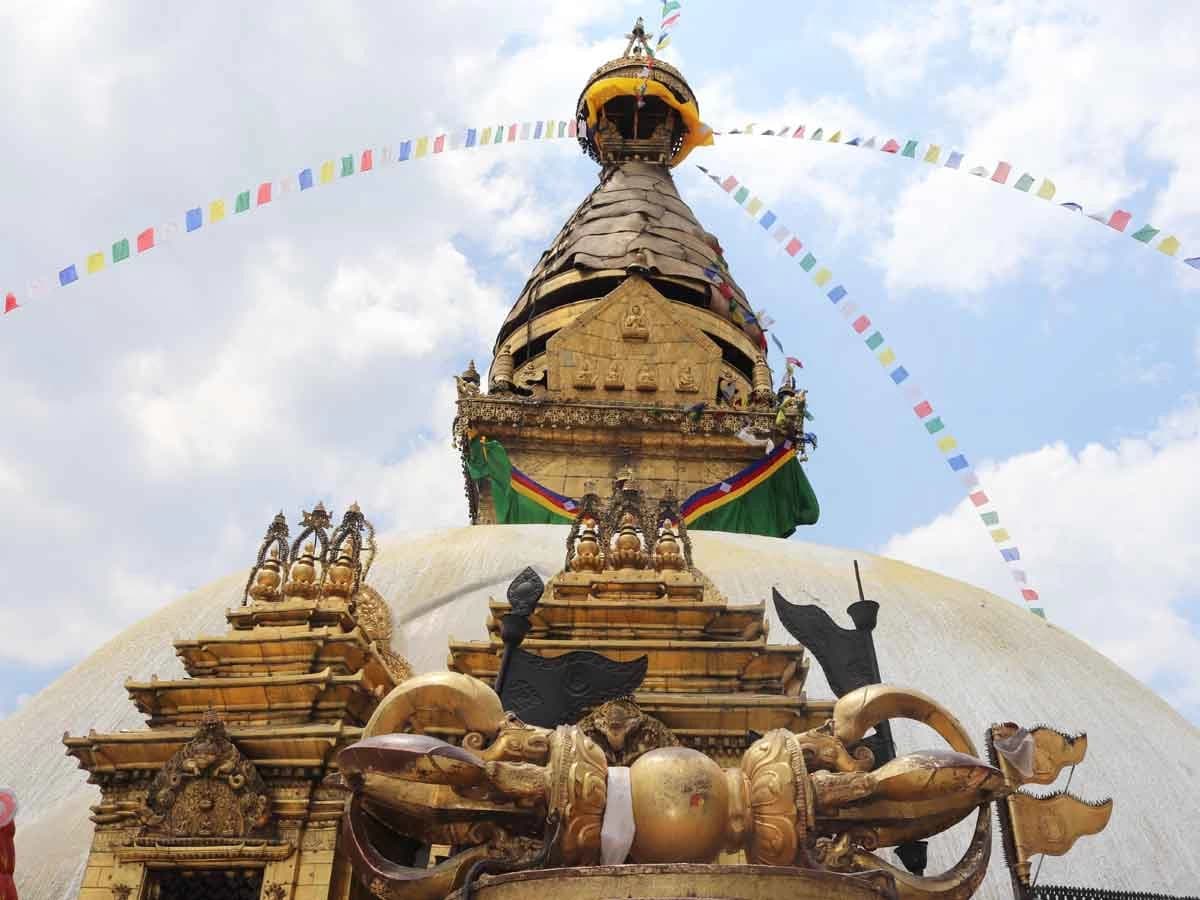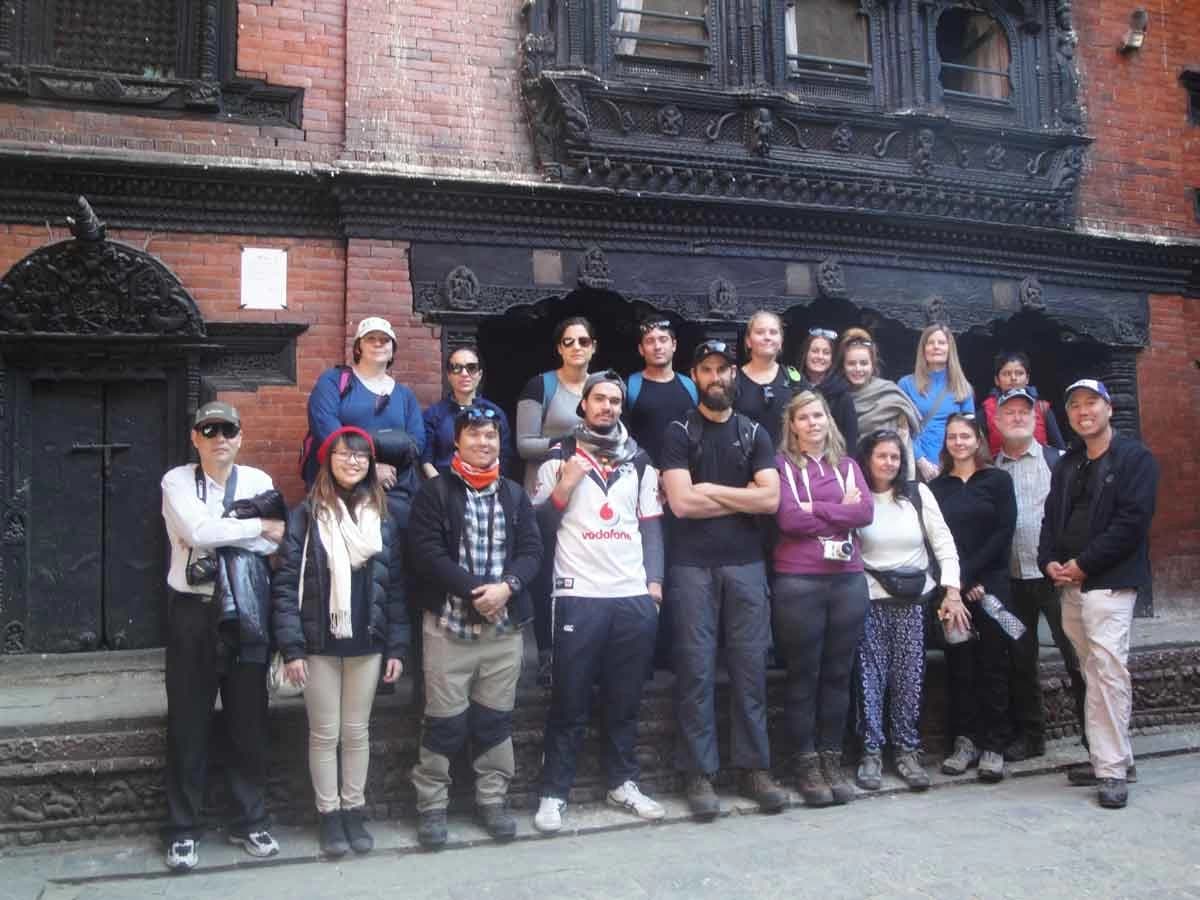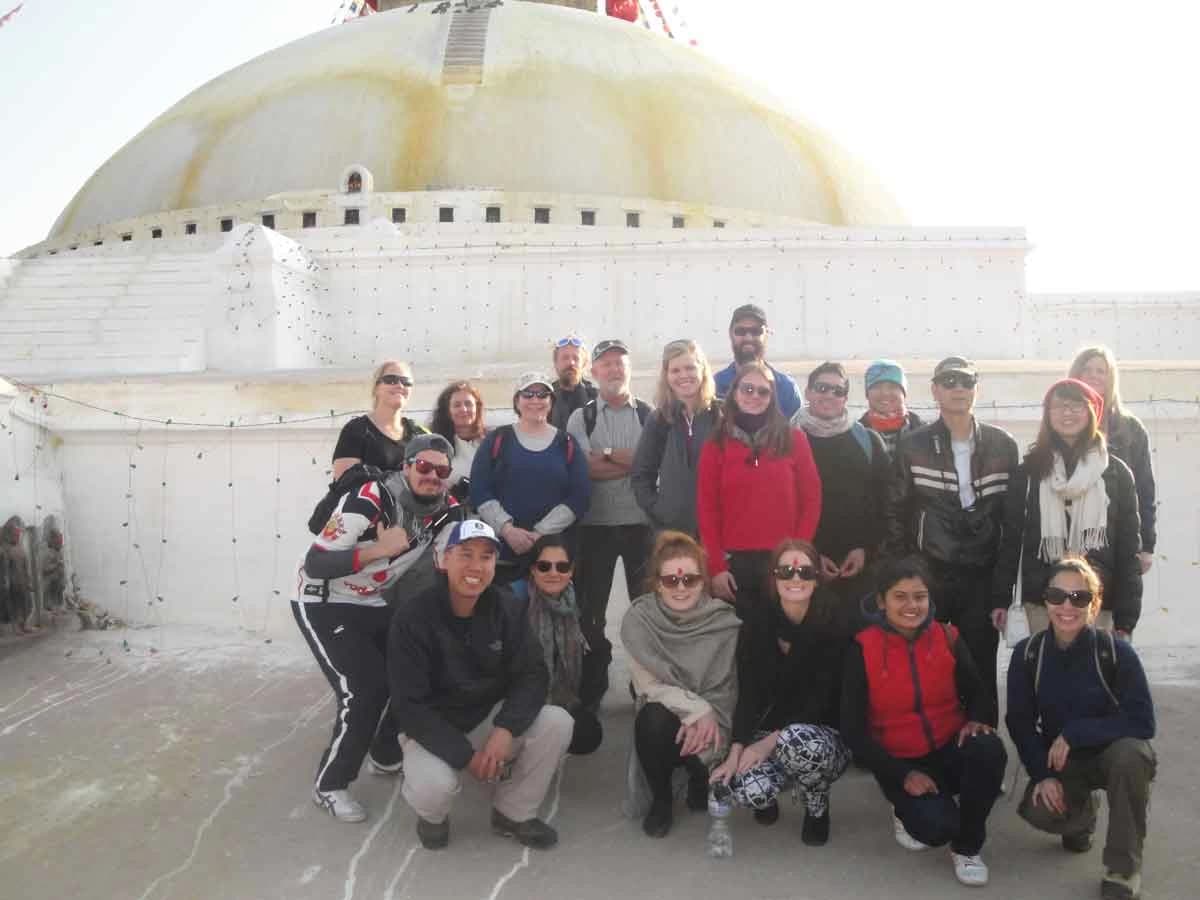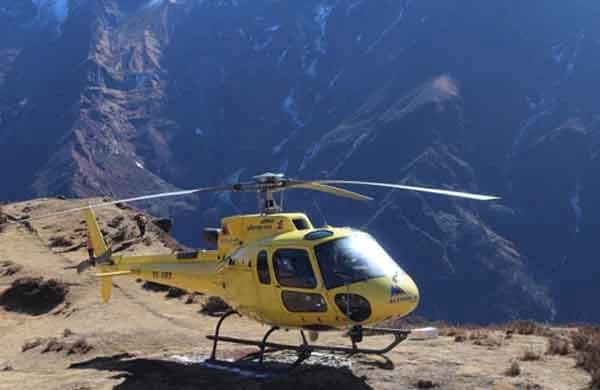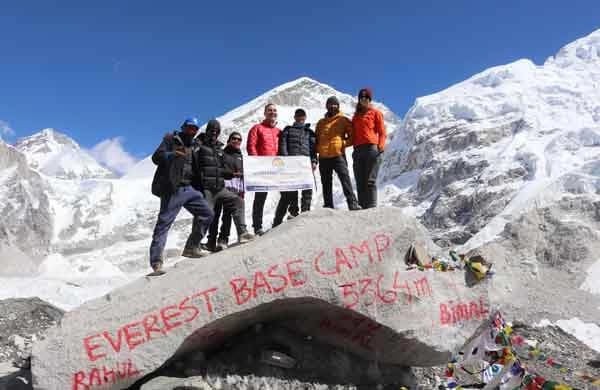Kathmandu day tour, known as the Kathmandu City Tour or Kathmandu Sightseeing, is the best way to understand Nepal's history and Nepali culture, beliefs, art, and architecture. Kathmandu Day Tour itinerary is well crafted and allows travelers to explore many historical sites in a limited time. We do not rush during the tour, so you will have plenty of time to look around the monuments and capture their essence.
Kathmandu Day Tour - 1 Full Day
Introduction to the Kathmandu Tour - 1 Full Day
You can opt for our Kathmandu Day Tour if you have a full-day or half-day free in Kathmandu. It is a 6-7 hour guided tour of four must-visit UNESCO World Heritage Sites in Kathmandu.
One of our experienced and friendly tour guides will guide you on the Full Day Kathmandu Trip. Guide will pick you up from your hotel before the Kathmandu day tour begins and drop you off afterward. We at Outfitter Himalaya provide a private tourist vehicle to commute between the monuments, which make the Kathmandu day tour hassle-free.
You will learn a lot about this mythical country and the people residing here on the Kathmandu One Day Tour. Not only is that, but all the places you visit for sightseeing in Kathmandu surrounded by local markets and eateries. To some extent, you will look closely at Nepalese tastes and lifestyles.
Anyone can join Outfitter Himalaya for the Kathmandu Sightseeing Tour. No age limit or experience is required, and the tour is easy and leisurely. Many people also understand this activity through sightseeing in Kathmandu, so they are clear. We offer the most genuine Kathmandu day tour price in the market. For the amount you pay, you will get the best service.
You do not necessarily have to book the Kathmandu tour in advance. You can contact us anytime, and we will do our best to arrange this tour for you.
Kathmandu Day Trip Highlights
- Kathmandu Day Tour is perfect option to spend your day in Kathmandu by visiting centuries-old historical sites
- Kathmandu day sightseeing is guided by one of our amiable, professional, and English-speaking guides who will introduce you to the monuments
- Kathmandu Day tour is 6- 7 hours guided tour of four must-visit UNESCO World Heritage Sites in Kathmandu that can be joined by people of all ages
- There is no rush during the Kathmandu Trip, so you will have plenty of time to explore the monuments and capture their essence.
- Understand Nepal's history and Nepali culture, beliefs, art, and architecture
- Have a close look into Nepalese tastes and lifestyles to some extent
- Explores tourist sites like Monkey Temple, Kathmandu Durbar Square, Pashupatinath Temple, and Boudhanath Stupa
- Best price, complete transparency, and no hidden charges
Places to Visit and Experience on Kathmandu Day Tour - 1 Day
Swayambhunath Stupa known as the Monkey temple
Swayambhu stupa, also known as Swayambhunath or the Monkey Temple, is one of Nepal's most sacred Buddhist sites. It is located on a hilltop in the Kathmandu Valley, approximately 3 kilometers west of the city center. The temple complex is believed to have been founded around 2,000 years ago and is revered by Buddhists and Hindus.
History of Swayambhunath
The history of the Swayambhu temple is steeped in myth and legend. According to Buddhist tradition, the site where the temple stands was once a lake that was believed to have been the source of the Kathmandu Valley. The lake is believed to be drained by the bodhisattva Manjushri, who cut a gorge in the hills to the south, allowing the waters to flow out and leaving behind a fertile valley.
The Swayambhunath temple is said to have been built to honor the lotus that grew at the lake's center.
Architecture of Swayambhunath
The temple complex consists of a stupa, several shrines, temples, and numerous prayer wheels. The stupa is the most prominent feature of the complex, a massive white dome with a golden spire on top. Several smaller stupas and statues of Buddha and other Buddhist figures surround it.
Religious Significance of Swayambhunath
- Swayambhu temple is considered one of Nepal's most important Buddhist pilgrimage sites.
- The temple is believed to be a source of great spiritual power, and many Buddhists come to meditate and pray at the site.
- The temple is also important to Hindus, who believe Vishnu built it.
- The Swayambhunath temple is also known for its resident population of monkeys, which are considered holy by both Buddhists and Hindus.
- The monkeys are believed to be the descendants of the monkey god Hanuman, a central figure in Hindu mythology.
Kathmandu Durbar Square, Ancient Royal Palace of Nepal
Kathmandu Durbar Square is a UNESCO World Heritage Site located in the heart of Kathmandu, the capital of Nepal. The square is a complex of ancient palaces, temples, shrines, and courtyards that date back to the 12th century. The site is renowned for its stunning architecture, intricate wood carvings, and beautiful stone sculptures. Kathmandu Durbar Square is one of Nepal's most important cultural and religious sites.
History of Kathmandu Durbar Square
The history of Kathmandu Durbar Square is closely linked to the history of the Malla dynasty, which ruled over the Kathmandu Valley from the 12th to the 18th centuries. The square was the Malla Kings' royal palace site, surrounded by temples, courtyards, and other public buildings. Over time, the square became a center of religious and cultural activity, and several significant temples and shrines were built in the area.
Architecture of Kathmandu Durbar Square
The architecture of Kathmandu Durbar Square is a fascinating blend of different styles and influences, reflecting the city's long and rich history. The buildings in the square are made from wood, brick & stone. Their intricate carvings and decorative details characterize them.
Many buildings feature traditional Newari architecture, known for its ornate carvings of animals, deities, and mythical creatures.
Religious Significance of Kathmandu Durbar Square
Kathmandu Durbar Square is considered one of Nepal's most important religious sites. The square has several significant temples and shrines, including the Taleju Temple, the Jagannath Temple, and the Kal Bhairav Temple.
Many temples are dedicated to the Hindu gods and goddesses, while others are associated with Buddhist practices. The square is also essential for festivals and religious celebrations, with colorful processions, music, and dance performances throughout the year.
One of the most important festivals celebrated in the square is the Indra Jatra festival, which is dedicated to the Hindu god Indra. It is celebrated in September every year.
Boudhanath Stupa – Biggest Buddhist Stupa in Nepal
Boudhanath Stupa, also known as Boudha Stupa, is a UNESCO World Heritage Site located in Kathmandu, the capital of Nepal. It is one of the largest and most significant stupas in the world. Boudhanath stupa is a popular destination for tourists and pilgrims from all over the world.
History of Boudhanath Stupa
Boudhanath stupa's history dates back to the 5th century. It is believed to have been built by King Manadeva of the Licchavi dynasty. Various rulers, including the Malla kings of the 14th century, later renovated and restored the stupa. The most recent restoration was carried out after the 2015 earthquake, which devastated Nepal and caused severe damage to the stupa.
Architecture of Boudhanath Stupa
Boudhanath Stupa is a massive dome-shaped structure that stands 36 meters high and has a diameter of 120 meters. A large circular market area, a popular destination for tourists and locals, surrounds the stupa. The structure is adorned with various symbols and intricate designs, including the Buddha's eyes and the Dharma chakra, representing wisdom and the wheel of law.
Religious Significance of Boudhanath Stupa
Boudhanath Stupa is an important religious site for both Buddhists and Hindus. It is believed to be the burial site of Kassapa Buddha, an important figure in Buddhist history. Boudhanath Stupa is also considered one of the holiest Buddhist sites in the world. It is a popular destination for Buddhist pilgrims who come to circumambulate it while reciting prayers or mantras.
The Boudhanath stupa is also an important cultural and historical site, with many nearby monasteries, temples, and shops. It is a center for Tibetan Buddhism in Nepal. It is home to many Tibetan refugees who have settled in the area.
Pashupatinath temple – the greatest Hindus Temple in Nepal
Pashupatinath Temple is a famous and revered Hindu temple dedicated to Lord Shiva. It is located on the banks of the Bagmati River in Kathmandu, Nepal's capital city.
Pashupatinath temple is considered one of the most significant pilgrimage sites for Hindus worldwide. It is also recognized as a UNESCO World Heritage Site.
History of Pashupatinath temple
The history of Pashupatinath temple dates back to the 5th century. However, the structure was built in the 15th century by the Lichchhavi King, Bhupatindra Malla. The temple has undergone several renovations and restorations over the centuries, with the most recent major restoration work taking place in the 17th century under the patronage of King Pratap Malla.
Architecture of Pashupatinath temple
The temple's architecture blends Nepalese pagodas and Shikhara style. The two-tiered roof is made of copper and embellished with gold. The temple stands on a raised platform and is built as a cubic structure, measuring 23.6 meters in height and 29.8 meters in width. The four main doors of the temple are covered with silver sheets, and the central courtyard has 518 small and large Hindu temples.
Religious Significance of Pashupatinath temple
Pashupatinath Temple is one of the most sacred pilgrimage sites for Hindus. It is believed that Lord Shiva appeared at this site as a linga (an abstract representation of Shiva) and has resided here ever since. The temple is also considered one of the twelve Jyotirlingas (radiant Lingas) in India and Nepal, making it even more significant for devotees.
The Pashupatinath temple is also believed to be a Mokshdham. In this place, one can attain liberation from the cycle of birth and death. The Pashupatinath temple attracts many pilgrims yearly, especially during the festival of Maha Shivaratri, when thousands of devotees worldwide come to pay their respects to Lord Shiva. The temple is also an important cultural and historical site.
- Day 01: Kathmandu full-day tour
9:00 to 10 AM: Meet your guide at your hotel in Kathmandu and start the Kathmandu day tour.
10:30 AM: Visit Swayambhunath temple, also known as the Monkey Temple. It is an ancient Buddhist stupa on a hilltop with a panoramic city view. Learn about the temple's history and religious significance and explore the complex.
11:30 AM: Head to Kathmandu Durbar Square, the city's historical center and another UNESCO World Heritage site. Explore the ancient palaces, temples, and courtyards and learn about the rich history and cultural heritage of the Malla dynasty.
12:30 PM: Head to Boudhanath and Visit the Boudhanath stupa, one of the largest stupas in the world and a UNESCO World Heritage site. Learn about the stupa's history and cultural significance and observe Buddhist prayer rituals and traditions.
1:00 to 2:00 PM: Stop for lunch at a restaurant and try some delicious Nepalese dishes.
2:00 PM: Head to Pashupatinath temple, one of the most sacred Hindu temples in the world. Located on the banks of the Bagmati River, the temple is dedicated to Lord Shiva and attracts thousands of pilgrims every year. Explore the temple complex, including the main temple, ghats, and other shrines.
3:30 PM: End the day tour and return to your hotel in Kathmandu. This itinerary comprehensively overviews Kathmandu's most significant cultural and religious sites. However, please note that the order of the itinerary may vary based on the location of your hotel and other factors.
- Transportation by private tourist vehicle
- Professional tourist guide
- A bottle of mineral water
- Monument entrance fees
- Tips for guide and driver
- Anything not mentioned in included section
Things to know before joining the Kathmandu Day tour
If you are planning to join a Kathmandu day tour, here are some tips and essential things you should know before you go:
Wear comfortable clothing and footwear
Kathmandu can be hot and humid (depending on when you travel), so you should wear lightweight and breathable clothing. Comfortable footwear is also essential, as you will walk a lot during the tour.
Carry a water bottle
Staying hydrated during the day tour is essential, so carry a refillable water bottle.
Be prepared for the weather
The weather in Kathmandu can be unpredictable, so check the forecast before you go and carry appropriate gear, such as a raincoat or umbrella ( if you are traveling during the monsoon).
Carry local currency
You must carry Nepalese currency to buy souvenirs, food, and entrance tickets. ATMs are widely available in Kathmandu, but carrying Nepali cash is always helpful.
Be respectful of local customs
Nepal is a conservative country, so it is essential to dress modestly and respect local customs and beliefs. Open your shoes before entering temples and look out for photography prohibition. Refrain from wearing shoes inside the temples and monasteries. Ask first to take photos. Many places prohibit taking photos.
Try the local food
Nepal has a rich culinary culture, and trying the local food is a must-do on the day tour.
Be aware of scams
As with any popular tourist destination, Kathmandu is prone to scams and pickpocketing incidents. Be aware of your surroundings and cautious when dealing with strangers.
Be aware of traffic
Traffic in Kathmandu can be chaotic, so be careful when crossing the streets and follow your guide's instructions.
Useful information for Nepal Travel
We had a wonderful five day tour of the Kathmandu valley with Outfitter Himalaya. This is the second time we've travelled with this company and wouldn't hesitate to do so...
We have Kathmandu tour with Outfitter Himalaya and our guide Sabita was fantastic and even accommodated our need to get to an airline office to check our flights back to...
I only had one free day during a busy visit to Nepal. The Kathmandu full day tour with Outfitter Himalaya allowed me to see as much of Kathmandu as possible....
